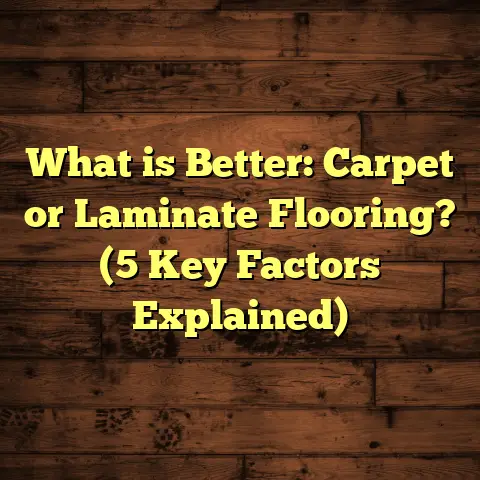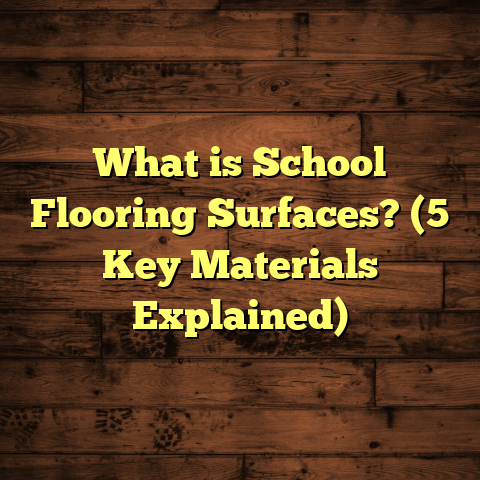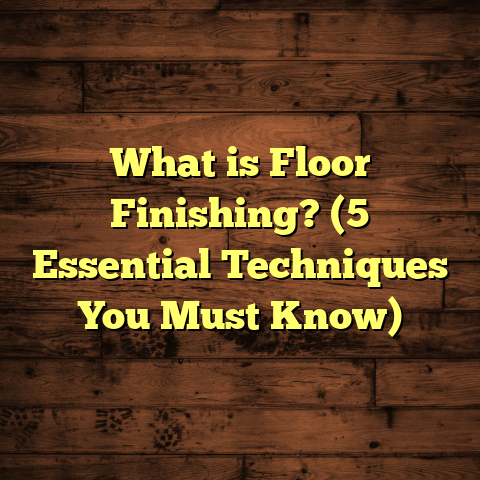What is Granite Flooring? (5 Benefits for Stunning Interiors)
I still recall the moment when I first really noticed granite flooring up close. It was during a renovation project for a client who wanted something durable yet elegant for their living room and kitchen. I remember stepping onto those polished granite tiles and feeling that solid, cool surface beneath my feet. It wasn’t just flooring—it was a foundation for style that promised to endure. That moment stuck with me because it made me realize how much a floor can influence the entire atmosphere of a space.
What is Granite Flooring?
At its core, granite flooring is made from granite—the natural stone formed deep within the earth’s crust. It’s an igneous rock, which means it’s created from cooled magma or lava, giving it a dense and hard composition. Granite mainly consists of quartz, feldspar, and mica, which combine to create its speckled texture and wide variety of colors.
Granite flooring involves cutting large granite blocks into slabs or tiles and then polishing these surfaces to reveal their natural brilliance. The polished finish highlights the stone’s unique patterns, which range from subtle flecks to bold veins. These characteristics make granite one of the most sought-after materials for both residential and commercial flooring.
When I first started working with granite floors years ago, I was struck by how each slab told its own story through natural variations in color and grain. Unlike manufactured flooring materials, granite carries the mark of nature’s artistry in every piece.
Granite flooring is not just about looks; it brings serious durability to the table. Its hardness makes it highly resistant to scratching and cracking—something I’ve witnessed firsthand on sites where granite floors have endured heavy foot traffic and even dropped tools without damage. And it’s not just tough—it’s also resistant to heat and moisture when properly sealed, making it ideal for kitchens and bathrooms.
The Science Behind Granite’s Durability
Granite’s durability comes from its mineral composition. Quartz is one of the hardest minerals on Earth, which contributes to granite’s scratch resistance. Feldspar provides its strength and resistance to weathering, while mica adds flexibility to prevent easy fracturing.
On the Mohs hardness scale—which measures mineral hardness—granite typically ranks between 6 and 7. For comparison, glass is about 5.5, and marble (another popular natural stone) ranks around 3 to 5. This means granite can handle daily wear and tear much better than softer stones.
This hardness also means granite is less porous than other stones like marble or limestone, which helps reduce staining and water absorption when sealed correctly.
Why Choose Granite Flooring? My Top 5 Benefits for Stunning Interiors
Having installed granite floors in dozens of homes over the years, I’ve seen how this material transforms spaces beyond just surface level changes. Here are the five benefits that keep me recommending granite again and again.
1. Unmatched Natural Elegance
Granite floors have a timeless appeal that simply doesn’t fade. The natural stone comes in a spectrum of colors—from deep blacks and browns to lighter grays, reds, greens, and even blues. The speckles and veins within each slab tell a story of geological time, making your floor a unique piece of nature.
I once worked on a home where the owner chose a rare blue-hued granite with striking white veins. The floor became the centerpiece of their living room, catching the light in different ways throughout the day. They told me friends would often ask if it was some kind of custom art installation.
The beauty of granite also works well with various interior styles. Whether you’re aiming for sleek modern minimalism or rustic warmth, granite can adapt beautifully. Its polished surface can reflect light to brighten up darker rooms or contrast nicely with matte walls or wood furnishings.
According to data from the Marble Institute of America, natural stone floors like granite can increase perceived home value by up to 15%, especially when used in key areas like kitchens and entrances.
2. Long-lasting Durability That Saves Money
I’ve often heard clients worry about investing in flooring that might need replacement too soon. Granite floors answer that concern with their impressive longevity.
Granite’s hardness makes it resistant to scratches from shoes, furniture legs, pet claws, and dropped objects. I’ve seen granite flooring stay pristine for decades with just basic care.
In fact, historical buildings with granite flooring still look great centuries later—proof that this material stands up over time.
On average, granite floors can last 50+ years when sealed and maintained properly. That far outlasts many engineered wood or laminate options that may need replacing after 10-20 years.
Investing in granite upfront can mean fewer repair costs down the road, which is a real advantage if you’re planning for your home’s long-term future.
3. Easy Maintenance After Proper Sealing
One of the biggest myths about natural stone floors is that they require excessive care. From my experience working with homeowners and contractors, this couldn’t be further from the truth—granite is relatively low maintenance once sealed.
Sealing fills in microscopic pores in the stone to create a waterproof barrier against spills and stains. I always recommend sealing new granite installations immediately after installation and reapplying sealant every few years depending on traffic levels.
A simple cleaning routine involving sweeping or vacuuming plus damp mopping with pH-neutral cleaners keeps granite floors looking fresh without damaging the surface.
One family I worked with had two energetic kids and a dog running through their kitchen daily. Despite frequent spills and messes, their granite floor remained spotless for years because they sealed it well and followed basic cleaning steps.
Compared to hardwood floors that can scratch easily or carpets that trap allergens and dirt, granite offers a practical balance between beauty and ease of use.
4. Design Flexibility with Variety
Granite’s natural color palette is vast enough to suit nearly any taste or décor scheme. From subtle earth tones to dramatic patterns, there’s a granite type for nearly every style preference.
Installation options are equally diverse. Granite slabs can be cut into large format tiles for a seamless modern look or smaller tiles arranged in mosaics or patterns for more decorative effects.
Granite also pairs well with other materials like wood or metal trims—something I often encourage clients to explore for personalized designs.
Another advantage I’ve found is how well granite works with radiant floor heating systems since it retains heat efficiently without damage.
For example, in one project involving a high-end kitchen remodel, we used black granite tiles combined with warm wooden cabinetry and brushed steel appliances. The result was a balanced design full of contrast yet harmony.
5. Healthier and Environmentally Sensitive Choice
If allergies are something you or your family deal with, granite flooring should be on your radar. Unlike carpets that trap dust mites, pet dander, mold spores, and other allergens, granite floors don’t harbor these irritants.
This makes breathing easier indoors—something many homeowners appreciate once they switch from carpeted rooms to stone floors.
Environmentally speaking, granite is a natural product extracted directly from quarries with minimal processing compared to synthetic flooring materials like vinyl or laminate.
When sourced from responsible quarries that practice sustainable extraction methods, granite is an eco-friendly option that lasts decades—reducing waste from replacements and synthetic manufacturing emissions.
How Granite Flooring Installation Works: Insights From My Fieldwork
Understanding how granite flooring is installed can help you appreciate why it’s priced higher than some other options but also why it lasts longer.
Granite slabs are heavy—often weighing over 20 pounds per square foot—so handling requires expertise and proper tools to avoid damage during installation.
Here’s an overview based on my experience:
Site Preparation
Before installation starts, the subfloor must be perfectly level and clean since any unevenness will show through thin stone tiles or slabs.
I always check moisture levels in concrete subfloors because excess moisture can affect adhesion or cause damage over time.
Dry Layout Planning
Positioning granite tiles before permanent installation ensures pattern continuity and reduces waste. Because each slab has unique veining or color spots, dry layout helps achieve a cohesive look without awkward seams.
Adhesive Application
Special thin-set mortar designed for heavy stones is applied evenly on the subfloor using notched trowels. This mortar secures the granite firmly in place once dried.
Setting Tiles/Slabs
Granite tiles are carefully placed into the mortar bed and gently tapped down for full adhesion without damaging edges.
I often use leveling systems during this step—tools that keep all tiles flush despite slight thickness variations—which helps avoid lippage (uneven tile edges).
Grouting & Sealing
Once mortar cures (usually after 24-48 hours), grout fills gaps between tiles to prevent dirt accumulation and provide finished looks.
After grout hardens, sealing seals both grout lines and granite surfaces for water resistance.
Post-Installation Care
I always advise clients to avoid heavy foot traffic for at least 48 hours after installation to allow full cure of adhesives and sealants.
Granite Flooring Costs: Real Numbers From My Projects
Cost is one of the first questions I get asked about granite flooring—and understandably so.
Here’s what you should expect based on recent projects I’ve managed:
- Material costs: Granite tiles vary widely depending on color rarity, thickness, size, and finish quality. Prices generally range from $5 to $15 per square foot.
- Installation labor: Because of the weight and handling challenges involved, professional installation usually costs between $8-$15 per square foot.
- Sealing & finishing: Initial sealing can add about $1-$2 per square foot; resealing every few years costs less.
- Waste factor: On average, plan for about 10-15% extra material to cover cuts and breakage during installation.
For example, installing granite flooring in a 1,000 square foot kitchen and living area might cost roughly $13,000 – $30,000 total depending on choices made.
Using tools like FloorTally has helped me provide clients with detailed estimates quickly based on local labor rates combined with material prices in their region. FloorTally also adds waste percentages into calculations automatically—which means fewer surprises mid-project!
Real Case Study: Transforming an Older Home With Granite Floors
One memorable project involved an older craftsman-style house whose original hardwood floors were badly damaged by moisture over time. The owners wanted something durable but classy for their remodeled kitchen and hallway areas.
After discussing options together—including engineered wood and porcelain tile—we chose honed (matte finish) granite tiles in warm gray tones.
The installation took about two weeks due to subfloor prep needs but was worth every moment.
Six months later during a follow-up visit, the homeowners told me:
- “We love how cool the floors feel underfoot even during summer.”
- “Cleaning is easy—we just sweep regularly.”
- “Our house feels more open thanks to light reflecting off the polished surfaces.”
- “Guests always comment on how unique our floors look.”
The project showed me again how granite can change not only aesthetics but also lifestyle comforts at home.
Comparing Granite Flooring With Other Popular Options: What Fits Your Needs?
Since you might still be weighing your options, here’s a detailed comparison between granite flooring and other common choices:
| Feature | Granite | Marble | Hardwood | Ceramic Tile | Vinyl/Laminate |
|---|---|---|---|---|---|
| Durability | Very High | Moderate | Moderate | High | Low-Moderate |
| Scratch Resistance | Excellent | Poor | Moderate | Good | Poor |
| Moisture Resistance | High (with sealing) | Low | Low | High | Moderate |
| Maintenance | Low (with sealing) | High | Moderate | Low | Low |
| Aesthetic Appeal | Natural & Unique | Elegant & Soft | Warm & Classic | Versatile | Artificial |
| Lifespan | 50+ Years | 20-30 Years | 10-20 Years | 25+ Years | 5-10 Years |
| Cost (Material + Install) | High ($13-$30/sq ft) | High | Moderate | Low-Moderate | Low |
| Allergy Friendly | Yes | Yes | No | Yes | No |
Why Granite Might Be Worth the Investment
If you value durability paired with natural beauty—and want your floors to last decades without constant upkeep—granite stands out as one of the best choices available today.
While initial costs might be higher than synthetic or softer materials, you save money long-term by avoiding replacements or repairs common with wood or laminate floors.
Granite also fits well in homes where moisture or heat exposure is frequent—something hardwood can’t always handle gracefully.
My Personal Tips For Anyone Considering Granite Floors
Based on what I’ve learned after years working with granite flooring—here are some tips if you’re thinking of installing it yourself:
- Choose quality slabs: Don’t go for cheaper pieces just because they cost less; thicker slabs resist breaking better.
- Hire experienced installers: Granite is heavy and fragile during transport; skilled pros reduce risk of cracks.
- Seal well: Make sure sealing is done immediately after installation.
- Plan your budget carefully: Factor in waste material; I usually tell clients to add 10-15% more material than just room dimensions.
- Consider finish types: Polished looks shiny but shows scratches more easily; honed offers matte finish hiding marks better.
- Pair wisely: Match your granite color with cabinetry or wall tones for balanced interiors.
- Maintenance routine: Sweep regularly; clean spills fast; reseal every few years.
Wrapping Up My Take On Granite Flooring
Granite flooring isn’t just another option—it’s a statement of style combined with practical strength that few materials match today. Over many projects and homes I’ve worked on, I’ve seen firsthand how it elevates interiors while standing up to everyday use without fuss.
If you want floors that last multiple lifetimes while looking incredible day after day—and don’t mind investing upfront for quality—you’ll find few better choices than granite.
And remember: tools like FloorTally make budgeting easier than ever so that you know exactly what you’re getting into financially before starting your project. That peace of mind goes a long way toward enjoying the process!
Feel free to reach out if you want tips on sourcing quality granite or need advice on installation methods—I’m happy to share what I’ve learned from thousands of square feet laid down around homes just like yours!
Would you like me to add detailed maintenance schedules or troubleshooting tips next? Or perhaps expand on specific design ideas using different types of granite? Let me know!





